|
County Armagh.
BY CHARLES D. TRIMBLE.
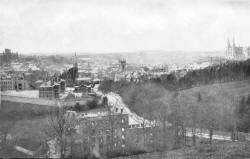 |
| GENERAL VIEW OF THE CITY OF ARMAGH |
ARMAGH is perhaps the most important county in Ulster from the tourists
point of view. He who would know the story of Ulster or even of Ireland
must begin his studies in the ecclesiastical capital, for from the City
of Armagh, Ireland's Canter-bury, in every age messengers have gone
forth carrying and bringing back tidings which have opened and closed
chapter after chapter in the history of Ireland. In the straggling,
hilly streets of this beautiful old city you may spend many happy hours.
But you must not go alone. It is a place for those who need the company
of another, for whom the charm of old things is increased a hundred
fold, if some kindred spirit feels it too. The City of
Armagh.
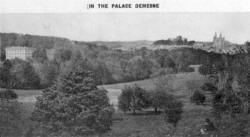 Just how old is the City of Armagh even archaeologists do not know. It
is named after Queen Maha, but there were three Mahas, and whether Ard
Maha--The Hill of Maha�is called for that famous Maha who built the
great Navan Fort outside the present city, or whether her earlier
namesake named the hill itself 3,000 years B.C., legend does not say
with certainty. One thing is certain, there was bound to be a city on
Armagh's hills, for it is situate where the two great roads into the
Ulster Basin meet. One, the famous Moyry Pass, is probably the route by
which the men of the Iron Age entered to drive the earlier settlers of
the Bronze Age into Counties Down and Antrim, as later it was the way by
which the great road from Tara passed through the Southern Ulster
Mountains from the central plain of Ireland. The other road is the
Monaghan corridor between the Armagh mountains and the water-logged
country about Lough Oughter and Lough Erne. One of the most beautiful of
Irish cities, Armagh was about 300 B.C. the seat of the Warrior Queen
Maha, who compelled her captives taken in battle to build the great
palace at Emhain Maha, of which the mounds and deep ditches can still be
seen to-day, girdling the high hill which became for hundreds of years
the centre of government for Ulster, and gave the city that importance
which probably influenced St. Patrick later to make it the
ecclesiastical centre of Ireland, which it has remained ever since. Just how old is the City of Armagh even archaeologists do not know. It
is named after Queen Maha, but there were three Mahas, and whether Ard
Maha--The Hill of Maha�is called for that famous Maha who built the
great Navan Fort outside the present city, or whether her earlier
namesake named the hill itself 3,000 years B.C., legend does not say
with certainty. One thing is certain, there was bound to be a city on
Armagh's hills, for it is situate where the two great roads into the
Ulster Basin meet. One, the famous Moyry Pass, is probably the route by
which the men of the Iron Age entered to drive the earlier settlers of
the Bronze Age into Counties Down and Antrim, as later it was the way by
which the great road from Tara passed through the Southern Ulster
Mountains from the central plain of Ireland. The other road is the
Monaghan corridor between the Armagh mountains and the water-logged
country about Lough Oughter and Lough Erne. One of the most beautiful of
Irish cities, Armagh was about 300 B.C. the seat of the Warrior Queen
Maha, who compelled her captives taken in battle to build the great
palace at Emhain Maha, of which the mounds and deep ditches can still be
seen to-day, girdling the high hill which became for hundreds of years
the centre of government for Ulster, and gave the city that importance
which probably influenced St. Patrick later to make it the
ecclesiastical centre of Ireland, which it has remained ever since.
Old as Armagh is, its history is packed with legend and story, from the
time when Maha first traced Emhain Maha with her brooch, until in later
times the O'Neills and O'Donnells under the Red Hand Banner drove
English troops in rout from the Blackwater, slaying their General,
Marshall Bagenal, or later still Primates expended their fortunes on the
wonderful Library cr the Observatory or on restoring the Cathedral.
Emhain Maha became the home of the Red Branch Knights, who for hundreds
of years were to Ireland what Arthur's Knights of the Round Table were
to England. Under Conor, King of Ulster, there arose heroes whose deeds
vie with those of the Odyssey, and whose fights were sung by the
harpists. Probably the oldest church in Ulster still in use, the old
Protestant Cathedral of Armagh stands on the site where in 445 St.
Patrick built his first
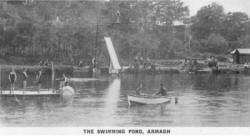 cathedral. Part of the present building is said
by some to date from the eighth century, and the present building was
commenced in the thirteenth, being restored in the eighteenth century.
In the grounds beside it are buried King Brian Boru and his son Morrough
O'Brian, who in 1014 were killed after defeating, at Clontarf in County
Dublin, the Danes and Northmen who had ruled Armagh, sacked and burned
the Cathedral, and maintained a fleet on Lough Neagh. Not half a mile
from the city, on the banks of the Callan River, lies the cenotaph of
King Niall Caille, drowned there in 846 when warring with those same
invaders. cathedral. Part of the present building is said
by some to date from the eighth century, and the present building was
commenced in the thirteenth, being restored in the eighteenth century.
In the grounds beside it are buried King Brian Boru and his son Morrough
O'Brian, who in 1014 were killed after defeating, at Clontarf in County
Dublin, the Danes and Northmen who had ruled Armagh, sacked and burned
the Cathedral, and maintained a fleet on Lough Neagh. Not half a mile
from the city, on the banks of the Callan River, lies the cenotaph of
King Niall Caille, drowned there in 846 when warring with those same
invaders. Grouped round the old Cathedral are many noble buildings,
including the Library which Primate Robin-son endowed in 1781, and which
ranks amongst the first three in Ireland. Over its porch an inscription
in Greek characters is typical of the spirit of the place�"Pseuches
latreion," the "Medicine Shop of the Soul." From the Library windows the
city may be seen at its best. Close by is The Primate Alexander Memorial
Hall, erected in the present century in honour of the poet Primate. Mrs.
Alexander it was who wrote the well-known hymns " There is a Green
Hill," and "Once in Royal David's City." Across the valley on the
opposite hill are lifted high to heaven the twin spires of the National
Cathedral of St. Patrick, erected by the Roman Catholic Church by
National subscription "cum Gloire De agus Onora na h'Eireann" ("To the
Glory of God and the Honour of Ireland"), and as a memorial to the
National Apostle, St. Patrick. In the old Cathedral are some fine
Brasses and many old Regimental and Volunteer colours, including a
French colour, the only enemy colour ever captured within the British
Islands, and the only colour ever taken in battle by a British Regiment
of Militia. It was taken from the French at Ballinamuck in 1798 by the
Armagh Light Infantry, when the French General Humbert invaded Ireland.

The Observatory was founded in the year 1791 by Primate Robinson, Baron
Rokeby, on Knockamel (The Hill of Honey), from which was issued in 1859
"The Armagh Star Catalogue," still a standard reference amongst
astronomers. Here is to be seen the largest telescope in Ireland, with
some unique clocks and instruments. The Astronomer, Rev. W. F. A.
Ellison, welcomes visitors if he receives notice of their coming. The
Observatory building itself is a remarkably fine specimen of a small
Georgian house. The Primate's Palace, a fine old Georgian Mansion and
once a Royal Palace, was built by Primate Robinson. It stands in the
Palace Demesne and contains many fine paintings, including portraits of
all the Primates since Henry Usher, who came to the Archiepiscopal Chair
in 1595.
St. Patrick's Well is about a mile outside the city, on the Old Coach
Road to Killylea and the West of Ireland. There is a pilgrimage there on
the eve of the feast of Saints Peter and Paul on 29th June, when
tradition has it that the well overflows at midnight. St. Brigid's
Well, in the Palace Demesne, is also said to overflow once in a year.
On the Benburb Road, some two miles from the city, and a half mile
across country from the Navan Ring, is a circle of large stones known
locally as "The Druid's Ring." It is actually the remains of an old
burial cairn, and legend has it that close by Conor MacNessa, a famous
king under whom the Red Branch Knights reached their greatest fame, was
buried. Beside the city at Deans Hill is a square Georgian house built
in 1765. Once the residence of the Deans of Armagh, it is now occupied
by Senator The Rt. Hon. H. B. Armstrong, H.M.L., whose record of public
service, extending over sixty years, is equalled by few in the country.
The "Book of Armagh," now in Trinity College Museum in Dublin, is one of
the few books which have come down from the early days of history. It
contains a life of St. Patrick by himself, and a copy of the New
Testament, and there are those who believe that St. Patrick himself
composed part of it. The bell of St. Patrick is now in the National
Museum, Dublin, and was used at the recent Eucharistic Congress in
Dublin. The Shrine of the Bell is the most interesting specimen of the
kind now existing. St. Patrick founded at Armagh a School which became
famous throughout Europe. To-day the Royal School, founded in 1608,
carries on the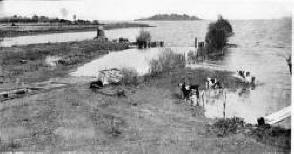 work begun many years before. The great Lord Castlereagh
and the historian Lecky were amongst famous pupils of the past. work begun many years before. The great Lord Castlereagh
and the historian Lecky were amongst famous pupils of the past. Beside
St. Patrick's (Roman Catholic) Cathedral is the Diocesan College,
carried on by the Vincentian Fathers. In Armagh the Golf Club welcomes
visitors, and there is abundance of fine trout fishing in the Callan and
Blackwater. Holiday makers who seek a quiet inland resort, students of
history, lovers of nature and the touring motorist will be delighted
with a stay at this old city. The Great Northern Railway connects the
city with Belfast and Dublin via Portadown, and there are good bus
services, by which it is possible to reach all parts of Ulster. Two
Swimming Pools, one large and one small, have been provided by the Local
Authority, and add to the holiday amenities.
Kilmore.
Half a dozen miles north
of Armagh, close to the Portadown Road, is Kilmore�The
Great Church. Kilmore Parish Church in antiquity yields only to the
Cathedrals of Armagh and Derry, and possibly is older than either, as it
is reputed to date from 422 A.D. The Square Tower has walls of immense
thickness, and these are the more extraordinary in that they enclose the
almost perfect round tower of the Monastery of Cill Mho'r. Little is
known of the Monastery, but it is reported to have been founded by St.
Mochto in the fifth century.
 Maghery.
A dozen miles north to the shores of
Lough Neagh is Maghery, a hamlet which lies close to the fruit
district. The hotel here has become in recent years the headquarters of
a popular tour. Nearby is Coney Island, and old Ordnance Survey Maps
show "St. Patrick's road said to run through the Lake" to the island.
Portadown,
Once Port-ne-dun, the Port of the Fort, situated some 10
miles north-east of Armagh, on the main road to Belfast, is one of the
most thriving
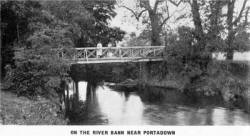 industrial and market towns in Ulster. It is in the heart
of the fruit-growing country which has earned for County Armagh the
title of "The Garden of Ulster," It is a great linen centre, and by
reason of its bridge over the River Bann, is the gateway through which
traffic for western and south-western Ireland must pass. It is the
railway junction for the main railway lines from Belfast, Dublin, Derry,
Armagh, and the Midlands of Ireland. industrial and market towns in Ulster. It is in the heart
of the fruit-growing country which has earned for County Armagh the
title of "The Garden of Ulster," It is a great linen centre, and by
reason of its bridge over the River Bann, is the gateway through which
traffic for western and south-western Ireland must pass. It is the
railway junction for the main railway lines from Belfast, Dublin, Derry,
Armagh, and the Midlands of Ireland. Industrially, Portadown has many
linen weaving and handkerchief factories, foundries, flour mills,
bacon-curing factories, a furniture factory, a spinning mill and a cider
factory, while its roses are known wherever roses are loved and grown.
The Bann Basin with its bogs offers the sportsman fishing and shooting,
while the 30 acre public park, with its pleasant river, is yearly
growing in beauty as the gardener's work develops the shrubberies and
coppices through which its pleasant walks meander. A new bowling green
and a pleasure garden have recently been laid out beside the centre of
the town on the banks of the Bann, while other amusements include
football, fishing, golf, tennis, with numerous reading and recreation
rooms. Close by was born "AE"�G. W. Russell, poet, painter, economist
and a remarkable journalist. Another distinguished Portadown man was
Sir Robert Hart, first Inspector General of the Imperial Customs in
China, who has been described as " The most influential, and most
upright European the East has ever known." By his straightforwardness he
made British integrity respected in the far East. A tablet has been
erected by the Ulster Tourist Development Association, Ltd., to
commemorate this famous Ulster-man's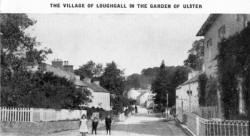 birthplace, and can be seen at his
father's residence. birthplace, and can be seen at his
father's residence.
From Portadown to Richhill, Kilmore and Loughgall a network of roads
runs through a district covered with fruit trees and plants. You may
drive through this garden by narrow lanes and broad roads, coloured and
scented by the pink and white bloom of fruit trees, by schools and
villages which are gardens in themselves. The centre of the district is
Loughgall, a quaint old place more English than Irish in design. Its one
long street runs into a little valley and rises again, and, unlike the
customary white of Ireland, most of its thatched cottages are coloured
the pink of apple blossom. Lurgan.
Five miles from Portadown on the Belfast Road is Lurgan�The Long Ridge�one of the chief centres of the
linen industry, and the home of handkerchief making and embroidery.
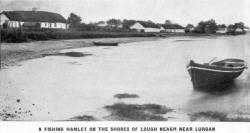 Once in O'Neill's land, Lurgan, or the parish of Shankill, was forfeited
to the Crown after the flight of the Earls, and in 1609 William Brownlow
was given 2,500 acres which included the parish to "plant." With English
families he founded the town, but in the Rebellion of 1641 Sir Phelim
O'Neill destroyed it, and until the reign of King Charles II. no real
effort was made to rebuild. Then the War of the Revolution broke out,
Mr. Brownlow opposed James II. and was outlawed, the town being again
destroyed. Once in O'Neill's land, Lurgan, or the parish of Shankill, was forfeited
to the Crown after the flight of the Earls, and in 1609 William Brownlow
was given 2,500 acres which included the parish to "plant." With English
families he founded the town, but in the Rebellion of 1641 Sir Phelim
O'Neill destroyed it, and until the reign of King Charles II. no real
effort was made to rebuild. Then the War of the Revolution broke out,
Mr. Brownlow opposed James II. and was outlawed, the town being again
destroyed. After the Battle of the Boyne, King William III. granted a
patent for fairs and markets, and the industryof the people in the land
made these valuable. When Queen Anne was on the throne William Waring,
M.P., introduced diaper manufacture, and from that time Lurgan has never
looked hack. Lurgan is not a mile from Lough Neagh, so that there is
good shooting and fishing, and other sports include tennis, golf,
cricket, football�both Association and Rugby�and hockey, and there are
good bowling greens. Visitors are welcomed. There is a splendid public
park beside the town, in what was the demesne of Lord Lurgan, descendant
of William Brownlow, who founded the town. The park contains a beautiful
lake of 53 acres. In Lurgan was born on 20th October, 1674, James
Logan, statesman and scientist, secretary to William Penn. He afterwards
became Chief Secretary of the State, Provincial Secretary and President
of the Council.
 Tandragee,
Five miles south-east of Portadown, and ten
miles east of Armagh, is of considerable antiquity. It was founded by
the O'Hanlons who helped to drive the Iberian princes from the Navan
Fort and from County Armagh in 332 ; by building their castle at
Tandragee, the O'Hanlons became guards whose duty was to keep the
dispossessed Iberians in Counties Down and Antrim.
The O'Hanlons were dispossessed when O'Neill and O'Donnell had to fly
in the first years of the 17th century and Tandragee was given to Sir
Oliver St. John, who rebuilt the town. In the Rebellion of 1641 the
O'Hanlons recaptured and destroyed the castle, about which time Capt.
Henry St. John was shot through the head and killed by Redmond O'Hanlon,
the highwayman. When the Parish Church, also built by Sir Oliver, was
being restored in 1812, the skull of Capt. Henry was found. In 1849
transepts were added to the church, and on that occasion the skull was
again exposed to view and it was stolen, but four days later was found
in the churchyard wrapped in brown paper. There is excellent fishing
near the town in the Cusher River. The industries are agriculture and
linen weaving. The southern half of the county is rich in glorious
mountain scenery, and is a paradise for the rambler and tourist. For the
antiquarian, too, it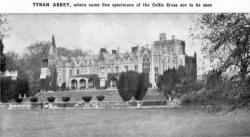 must be of intense interest, for there are many
relics of the old wild days of Irish history, also many souterrains, or
underground dwelling places, forts and dolmens, and it is a cradle of
some of the finest relics of history in Western Europe. must be of intense interest, for there are many
relics of the old wild days of Irish history, also many souterrains, or
underground dwelling places, forts and dolmens, and it is a cradle of
some of the finest relics of history in Western Europe. The best way
to reach this district is by road from Armagh or Portadown. By Portadown
the road runs through Tandragee and Poyntzpass, where the fourth of the
great Walls of Ulidia can be seen. From Armagh the route runs through
Markethill, where in Gosford Demesne, beloved of Dean Swift, there are
several Irish ringed forts. Gosford Castle is said to be the largest
house in Ireland. Bessbrook.
A prosperous village, near Newry, set
amid enchanting scenery, is an ideal centre from which to explore the
South Armagh mountains. Bessbrook itself has earned the distinction of
being looked upon as a model village. Close by is Deramore House, a
picturesque thatched residence, where the Act of Union was ratified in
1800. A short distance away, nestling in the Camlough mountains, is
Camlough Lake, which provides Newry Town with its water supply. The
surroundings are almost alpine in their picturesqueness, and a scheme of
re-afforestation when completed will add still further to the beauty of
this district. In South Armagh amongst the many interesting reminders
of bygone days is to be seen, near Slieve Gullion, that great earthwork
known as "The Worm's Cast" or "The Black Pig's Dyke," which ran right
across Northern Ireland to the Atlantic Ocean. This was the last of
three great defensive walls which from time to time separated the
Kingdom of Ulidia (Ulster) from Southern Ireland. The Cruithni, the
inhabitants of Ulidia, built them as a line of defence against the
Southern Celts. It is not known with certainty whether the Cruithni were
the aboriginal inhabitants or an admixture of the aboriginal and older
Celt. Along this great wall the Southern Celts defeated the Cruithni in
332 A.D., encroaching upon their territory and destroying Enchain Maha.
The Wall may be compared with that of Antennas from Forth to Clyde, or
to Hadrian's Wall. The road from Tara to Enchain Maha passed through the
fortifications at "The Dorsey" in the Marry Pass. "The Dorsey" means The
Gate", and was also known as "The Doors of Enchain," or as "Baffle na
n'doirre"�The Town of the Doors. The Dorsey" is an earthwork which
encloses 2,678 acres, and still has at its southern extremity The Stone
of Watching," where the sentries of Ulster kept guard on the gate. The
dun or fort is the largest in Ireland, and one of the most typical of
its kind in Western Europe. Subsequent to the defeat of the Cruithni
in 332 A.D. they built a new line of defence which runs from near
Banbridge, in County Down, right down to Jones-borough in the south of
Armagh, and established Rathkeltchar (Downpatrick) as the new capital of
Ulidia. The probability is that this last great fortification was built
between 333 and 340 A.D. This fortification is now apparently quite
wrongly called "The Dane's Cast." It was a great trench averaging about
30 feet wide, and is still some 15 feet deep in places. The most perfect
section now remaining is in Scarva Demesne (Co. Down) close by to which
is Lisnagade, a fine example of the great earth forts which intersected
the trench. SAFETY FIRST!
Might we remind motorists of the above national campaign?
Please do not take unnecessary risks; keep on the correct side of while
lines and remember that there always might he danger just around the
corner.
Safe driving will take you to Ulster's Beauty Spots. Dangerous driving
might take you to Hospital.
THANK YOU!
 |